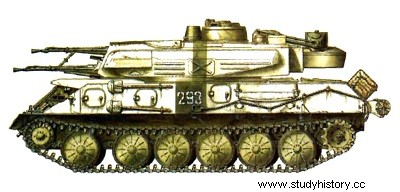
Type: self-propelled anti-aircraft gun.
Crew :4 men.
Armament: 4 x 23 mm Zu-23 cannons.
Armour: maximum:15 mm.
Dimensions:
length: 6.30m;
width: 2.95 m;
height (radar retracted):2.25 m.
Weight in combat order: 14 t
Ground pressure: 0.48 kg/cm2.
Engine :Model V-6 6 cyl. in-line water-cooled diesel, developing 243 hp at 1,800 rpm.
Performance:
road speed speed:44 km/h;
range :260 km;
vertical obstacle :1.10m;
straight cut: 2.80 m;
slope: 60%.
Time in Service:Introduced in the Soviet Army in 1964. Used by East Germany Bulgaria, Egypt, Finland, Hungary, India , Iran, Iraq, Poland, Syria, Czechoslovakia, Soviet Union, South Yemen. Still in production.
After the introduction in the late 1950s of highly accurate surface-to-air missiles, such as the SA-2 and the Bloodhound, aircraft had to resort to low flying to avoid detection. The standard Soviet self-propelled anti-aircraft gun in the 1950s was the ZSU-57-Z, but since it could not meet the new air threat, a new self-propelled gun had to be created. This is the ZSU-23-4, which the Soviets call "Shilka" and which made its first official release in 1965.
This vehicle is based on elements of the PT76 light tank. Its hull and its turret are assemblies made entirely of wrought steel, the shielding of which has a maximum thickness of 15 mm Its suspension, with torsion bars, comprises six road wheels, the tension wheel at the front and the sprocket at the back. The driver is at the front of the hull, on the left; the turret is in the center, the engine and the transmission at the rear.
Unlike the PT-76, the ZSU-23-4 is not amphibious, but it can ford to a depth of 1 m. It is equipped with an NBC system and infrared night vision equipment. It is armed with four 23 mm Zu23 guns, mounted in an electrically operated turret and allowing 360° azimuth firing; the elevation angle is from -7° to +80°.
The guns operate by gas recovery and are water cooled. Each has a cyclic rate of fire of 800 to 1,000 rounds/min but, in practice, each gun fires in bursts of 50 rounds in order to conserve ammunition. The ammunition load is 2,000 shells, or 500 per gun.
Two types of shells are used:the incendiary anti-tank and the incendiary explosive, both having an initial speed of 970 m/s. The guns have an effective anti-aircraft range of 2,500m.
Normally the vehicle stops to fire to provide a more stable firing platform, but it can also fire on the move .
A radar dish, nicknamed 'Gun Dish' is mounted at the rear of the turret, behind which it can be folded away if necessary. The role of this radar is twofold:first, it locates the enemy aircraft up to a distance of 20 km, then it follows the evolution of the target by keeping the guns pointed at it. The radar operates on the J wave length (formerly the Ku).
The ZSU-23-4 was first used operationally by Egyptian and Syrian forces during the Yom Kippur War in 1973. By most reports, it shot down more Israeli aircraft than any other weapon anti-aircraft, including SA-6 and SA-7 missiles.
In the Warsaw Pact forces, ZSU-23-4s are distributed four per motorized infantry regiment and eight per tank regiment. At the divisional level, there is an anti-aircraft regiment consisting of 4 batteries of six ZSU-23-4s. Each Soviet army group could deploy up to 128 of these weapons on its front. Currently the ZSU-23-4 is undoubtedly the most effective mobile anti-aircraft weapon in the world; but the German Gepard should prove superior, and the Americans are also preparing a mobile anti-aircraft weapon.
